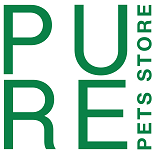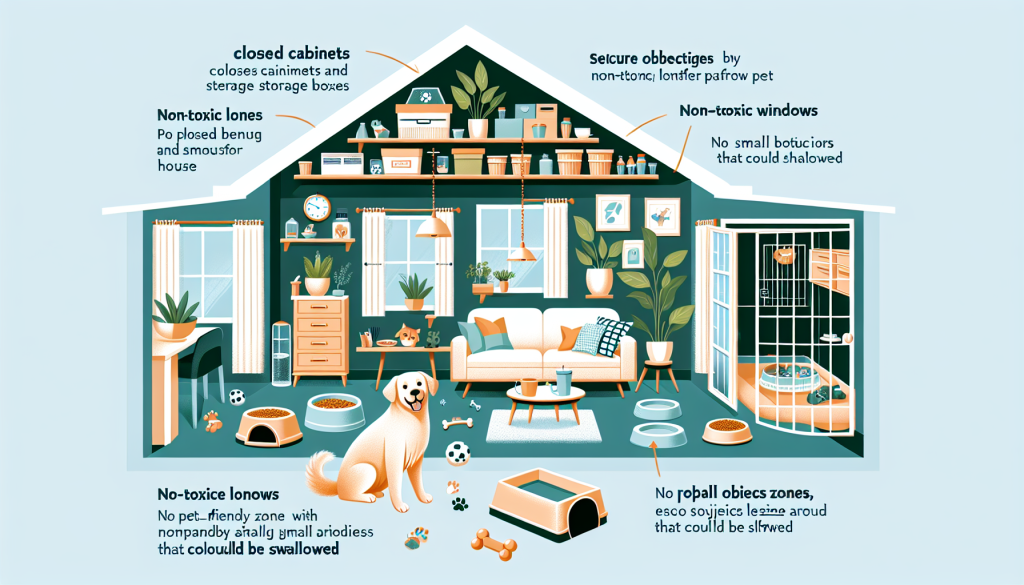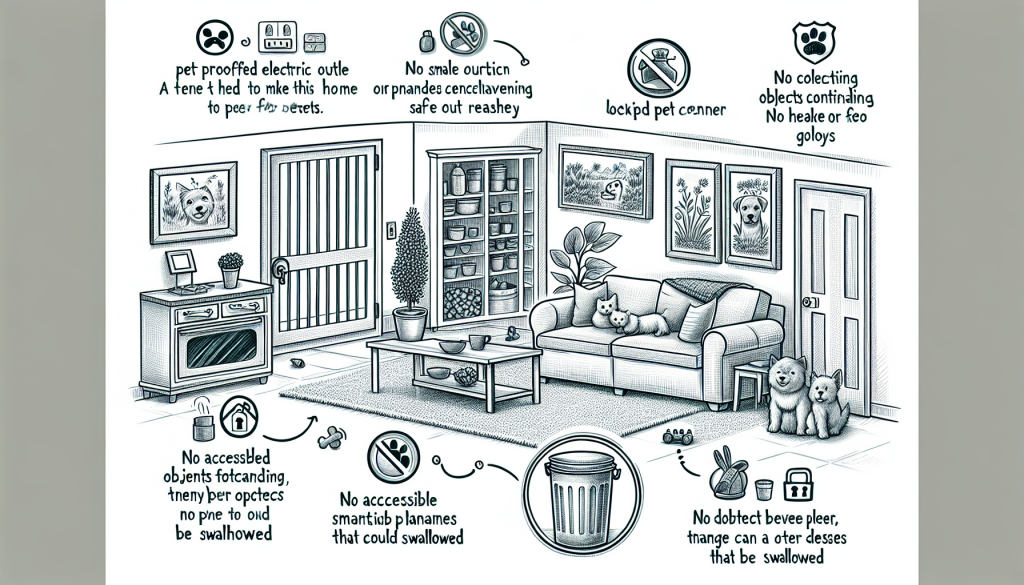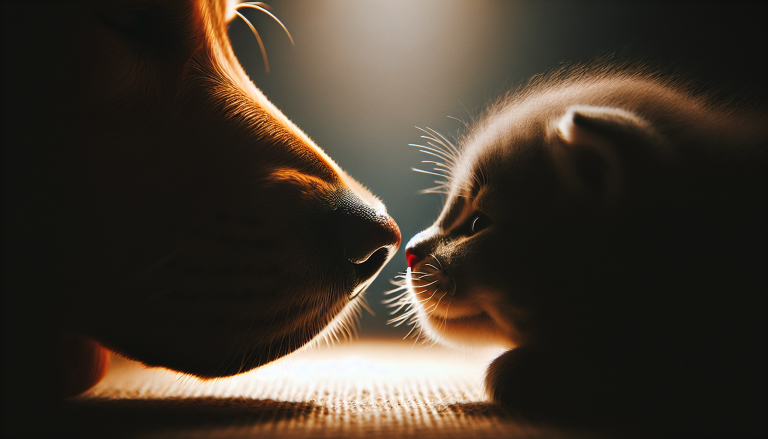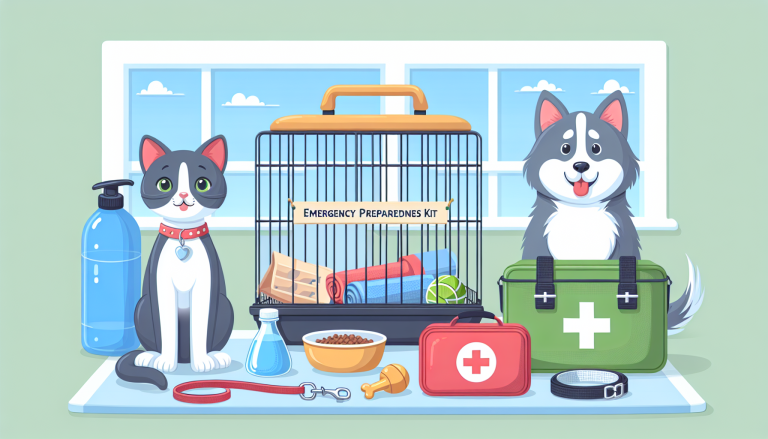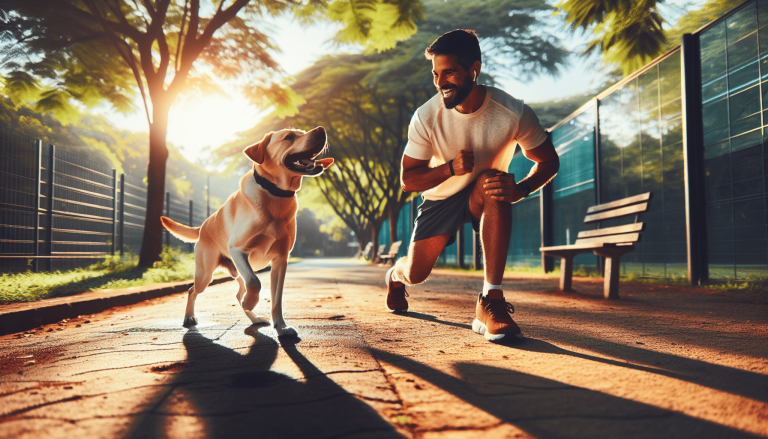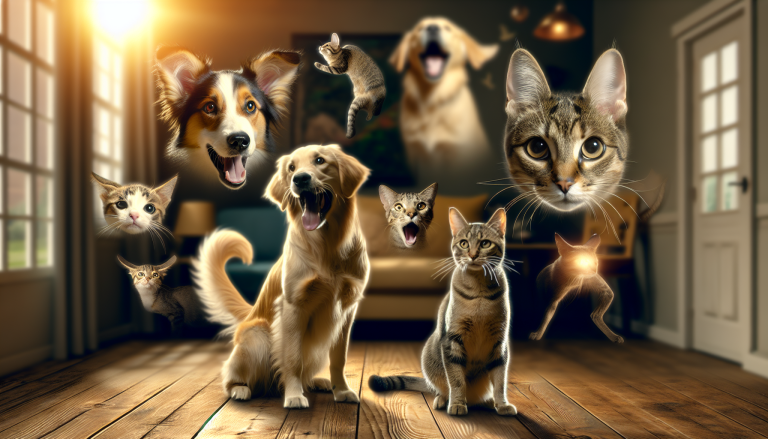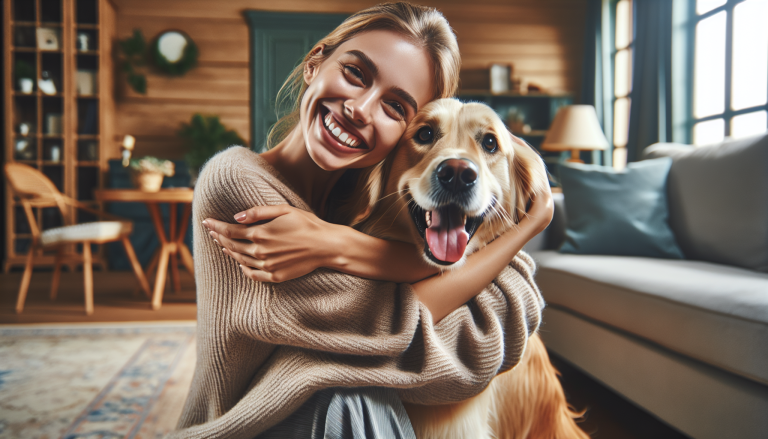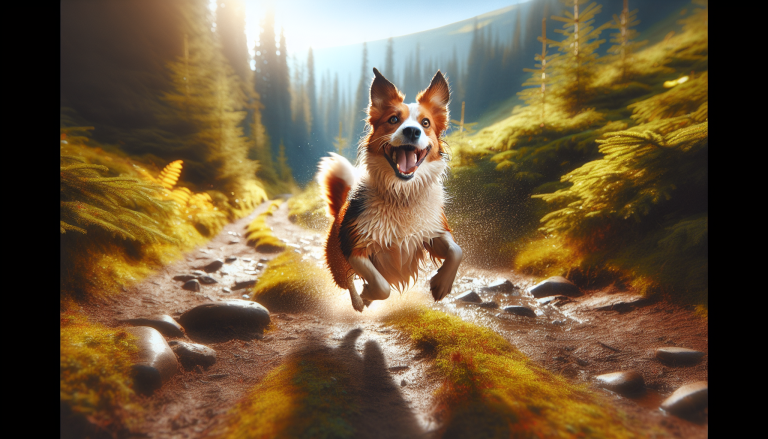Is your furry friend safe and secure in your home? Creating a safe environment for your pet is essential to ensure their well-being and happiness. With a few simple steps, you can transform your home into a sanctuary for your beloved companion. From securing hazardous items to creating comfortable spaces, this article will guide you through the process of making your home a safe haven for your pet. Get ready to discover practical tips and tricks that will give you peace of mind and keep your furry friend out of harm’s way.
Table of Contents
TogglePet-proofing your home
Pets are beloved members of our families, and ensuring their safety is of utmost importance. When bringing a new pet into your home or even if you’ve had your furry friend for years, it’s crucial to pet-proof your surroundings to prevent accidents and injuries. Here’s a comprehensive guide to help you identify and remove potential hazards in your home.
Identify and remove potential hazards
The first step in pet-proofing your home is to identify and remove any potential hazards that may be lurking around. Take a walk through each room and examine it from your pet’s perspective. Look out for small objects, loose cords, toxic plants, and other items that may pose a threat to their safety. By addressing these potential dangers, you can create a safer environment for your furry friend.
Secure loose cords and wires
Pets are naturally curious creatures, and dangling cords and wires can be enticing for them to explore. To prevent your pet from getting tangled or chewing on these hazardous objects, secure loose cords and wires. Use cord protectors or covers to keep them out of reach or tuck them away behind furniture where your pet cannot access them. This simple step can help avoid potential accidents or electric shocks.
Avoid toxic plants
Plants can add beauty and freshness to your home, but not all plants are safe for pets. Some can be toxic and potentially harmful if ingested by your furry friend. Research pet-friendly plants and avoid decorating your home with toxic varieties such as lilies, tulips, or azaleas. Choose pet-safe alternatives like spider plants, Boston ferns, or areca palms to add a touch of greenery without putting your pet at risk.
Keep cleaning products and chemicals out of reach
Cleaning products and chemicals are essential for maintaining a clean home, but they can be toxic to pets if accidentally ingested or inhaled. To prevent any mishaps, store these products in a secure location that is inaccessible to your pet. Consider using childproof locks on cabinets or keeping them on high shelves. Additionally, opt for pet-safe or natural cleaning product alternatives to ensure your pet’s safety.
Store medications in a secure location
Just like cleaning products, medications can be dangerous if consumed by your pet. Keep all medications, including over-the-counter and prescription drugs, in a secure location where your pet cannot reach them. Consider using a locked medicine cabinet or placing them in a high cupboard. It’s also essential to promptly dispose of any unused or expired medications as they can be tempting for curious pets.
Protect your pet from open flames
Open flames from candles, fireplaces, or stovetops can pose a significant risk to your pet. They can easily burn themselves or knock over items, causing a fire hazard. Use caution when using open flames and never leave them unattended while your pet is in the room. Consider using flameless candles or alternative decor options to minimize the risk of accidents or injuries.
Choose pet-friendly décor and furniture
When selecting décor and furniture for your home, it’s essential to consider its pet-friendliness. Avoid fragile or easily breakable items that can pose a danger to your pet if they accidentally knock them over. Opt for sturdy and pet-friendly materials that are easy to clean and maintain. Consider furniture with removable and washable covers to make cleaning up after your pet’s occasional messes a breeze.
Secure windows and balcony areas
Windows and balcony areas can be dangerous for pets if not properly secured. Ensure that windows have sturdy screens or guards to prevent your curious pet from slipping out or falling. Check for any gaps or loose fittings that may allow your pet to escape or get stuck. It’s also important to avoid leaving your pet unattended on balconies or high-rise areas to prevent accidents or falls.
Cover electrical outlets
Electrical outlets can be tempting for pets to explore, especially if they have an affinity for chewing. Prevent the risk of electrocution by covering electrical outlets with outlet covers or outlet plugs. These inexpensive and easy-to-install devices make it difficult for pets to access outlets and provide an extra layer of safety for your furry friend.
Beware of small objects and choking hazards
Pets, especially puppies or kittens, are known for their curious nature and tendency to explore the world with their mouths. Keep small objects and choking hazards out of their reach to prevent accidental ingestion or choking. Be mindful of items like coins, buttons, rubber bands, and small children’s toys. Regularly scan your home, especially the floors, for any potential hazards that your pet might find enticing.
Creating a safe outdoor environment
While our pets enjoy spending time indoors, it’s essential to create a safe outdoor environment where they can explore and play without exposing them to potential risks. Follow these guidelines to ensure your outdoor space is secure and hazard-free for your beloved companion.
Construct a secure and sturdy fence
A sturdy fence is the first line of defense to keep your pet safely contained within your property. Ensure that your fence is in good condition and does not have any gaps or loose boards that could allow your pet to escape. Opt for a fence with proper height, taking into consideration your pet’s breed and size. Regularly inspect the fence to address any potential weak spots or damage to maintain your pet’s safety.
Check for escape routes or gaps
While your fence may seem secure, it’s crucial to check for any potential escape routes or gaps your pet might exploit. Look for areas underneath the fence or holes in the ground that your pet could dig under. Block any open spaces or reinforce the fence with additional barriers to prevent your pet from finding a way out.
Ensure your garden is free of toxic plants
Just as you would in your home, it’s important to ensure your garden is free from toxic plants that can be harmful if ingested by your pet. Research and identify plants that are toxic to pets and remove them from your garden. Consider replacing them with pet-safe alternatives that can beautify your outdoor space without putting your furry friend at risk.
Store garden tools and chemicals safely
Garden tools and chemicals can be hazardous if left unattended or easily accessible to your pet. After using garden tools, promptly store them in a secure and designated area. Ensure chemicals such as fertilizers, pesticides, or insecticides are stored in their original containers and closed tightly. Consider using locked cabinets or dedicated storage spaces to prevent your pet from inadvertently coming into contact with these potentially dangerous substances.
Protect your pet from extreme weather conditions
Extreme weather conditions can pose a risk to your pet’s health and safety. Provide adequate shelter such as a doghouse, covered area, or even a cooling mat to protect your pet from excessive heat or cold. Pay attention to weather forecasts and bring your pet indoors during severe weather like storms or extreme temperatures. Offer appropriate clothing or accessories to help regulate your pet’s body temperature when necessary.
Consider pet-friendly landscaping options
Opt for pet-friendly landscaping options that are safe and non-toxic for your furry friend. Avoid using chemical-laden fertilizers, herbicides, or pesticides that may harm your pet if ingested or if they come into contact with them. Instead, explore organic or pet-safe alternatives that keep your outdoor space beautiful without compromising your pet’s well-being.
Provide access to shade and fresh water
When spending time outdoors, pets need access to shade and fresh water to stay comfortable and hydrated. Create shaded areas using trees, umbrellas, or covered patios where your pet can retreat from the direct sun. Ensure your pet always has access to clean and fresh water by providing multiple water bowls throughout your outdoor space. Check and refill them regularly to ensure your pet stays properly hydrated.
Prevent access to pools or bodies of water
While some pets may enjoy a dip in the pool, it’s crucial to keep them safe from potential accidents. Ensure your pool is properly secured with a fence and a gate that your pet cannot open or climb over. Consider using pool alarms or covers to further enhance safety. Even if you don’t have a pool, be cautious of other bodies of water such as ponds or large buckets as these can also pose drowning hazards for your pet.
Eliminate or secure potential wildlife attractions
Wildlife can be fascinating to observe, but encounters with certain animals can be dangerous for your pet. Remove or secure potential attractions that may entice wildlife, such as bird feeders or trash cans. These can draw in unwanted visitors that may cause harm to your pet. Keeping your outdoor space clear of these potential hazards can significantly reduce the risk of your pet being injured or coming into contact with a wild animal.
Regularly inspect and maintain outdoor areas
Regular inspections and maintenance are essential to ensuring your outdoor areas remain safe and hazard-free for your pet. Conduct routine checks to identify any potential risks, such as loose boards, holes, or toxic plants that may have grown back. Address these issues promptly to maintain a secure and enjoyable outdoor environment for your furry friend.
Food and water safety
Proper nutrition and hydration are vital for your pet’s well-being. To ensure your pet’s safety and prevent any illnesses or accidents, it’s crucial to implement sound food and water safety practices in your home.
Choose appropriate pet food and treats
Selecting the right pet food and treats is essential for your pet’s overall health and safety. Consult your veterinarian to determine the appropriate diet for your pet’s breed, age, and specific needs. Avoid feeding your pet table scraps or foods that are toxic to them, such as chocolate, grapes, or onions. Stick to high-quality, reputable brands and avoid products with potentially harmful ingredients.
Store food in a secure and pet-proof location
Storing pet food properly is crucial to prevent your pet from accessing it and potentially overeating or getting into food that may not be suitable for them. Keep all pet food in a secure, airtight container to maintain freshness and prevent attracting pests. Secure the container in a location that is inaccessible to your pet to avoid them breaking into it and causing a mess or potential health issues.
Prevent access to human food and harmful substances
Human food can be tempting for pets, but it’s important to keep it out of their reach as many items can be toxic or cause digestive issues. Store human food securely in closed cabinets or high shelves, especially items that are hazardous to pets, such as chocolate, caffeine, or alcohol. Be cautious of harmful substances like cleaning products, medications, and chemicals, ensuring they are stored safely away from your pet’s curiosity.
Ensure your pet has access to clean and fresh water
Water is crucial for your pet’s hydration and overall health. Ensure your pet always has access to clean and fresh water by providing multiple water bowls throughout your home. Regularly check the water bowls and refill them as needed. Consider investing in a pet water fountain that continuously circulates and filters the water, providing your pet with a constant supply of fresh water.
Regularly clean food and water bowls
Food and water bowls can accumulate bacteria and germs if not regularly cleaned. Establish a routine of washing your pet’s food and water bowls with hot, soapy water and rinsing them thoroughly. It’s also a good practice to sanitize them regularly to ensure proper hygiene and prevent any potential illnesses from bacteria buildup.
Keep an eye out for signs of food allergies or intolerance
Just like humans, pets can develop food allergies or intolerances. Keep a close eye on your pet’s behavior, appetite, and any signs of digestive issues after meals. If you suspect a food allergy or intolerance, consult with your veterinarian to determine the best course of action. They may recommend allergy testing or adjusting your pet’s diet to address any potential issues.
Consult with your veterinarian for specific dietary needs
Every pet has unique dietary needs, and it’s essential to consult with your veterinarian to determine the best diet for your furry friend. They can provide guidance on portion sizes, nutritional requirements, and any specific dietary concerns for your pet’s breed, age, or health conditions. Regularly consult with your veterinarian to ensure your pet’s diet is optimized for their overall well-being.
Avoid leaving food unattended or accessible on countertops
Leaving food unattended or easily accessible on countertops can lead to unwanted situations with your pet. They may help themselves to food that is unsafe or even create a mess in your kitchen. Avoid these potential issues by ensuring all food is properly stored and not left unattended. Clean up any spills or crumbs promptly to avoid attracting pests and to maintain a safe environment for your pet.
Follow proper storage guidelines for pet food
Pet food should be stored according to the manufacturer’s guidelines to maintain its freshness and avoid any potential contamination. Pet food should be kept in a cool, dry place away from direct sunlight or extreme temperatures. Always seal the bag or container tightly after each use to prevent the food from spoiling or attracting pests.
Dispose of leftover and spoiled food properly
Properly disposing of leftover or spoiled food is crucial to ensure your pet’s safety and prevent the growth of harmful bacteria. Avoid leaving pet food out for extended periods, as it can spoil and become a breeding ground for bacteria. Dispose of any uneaten food promptly and clean the food bowl before providing fresh food to your pet.
Preventing accidents and injuries
As pet owners, it’s our responsibility to protect our furry friends from accidents and injuries. By implementing preventive measures and practicing vigilant supervision, we can significantly reduce the risk of harm to our pets.
Provide adequate supervision and attention
One of the most effective ways to prevent accidents and injuries is to provide adequate supervision and attention to your pet. Be aware of their whereabouts at all times, especially in potentially hazardous areas of your home. Engage in interactive playtime, regular exercise, and mental stimulation to keep your pet mentally and physically engaged. By being present and attentive, you can quickly address any potential dangers and redirect their behavior when necessary.
Keep doors and windows closed or screened
Open doors and windows can provide an opportunity for your pet to escape or potentially injure themselves. Ensure doors leading to the outside are properly closed and secured. Keep windows closed or use sturdy screens that are securely in place to prevent your pet from falling or getting stuck. Regularly check screens for any signs of damage or wear and promptly repair or replace them as needed.
Use pet gates or barriers for restricted areas
There may be areas in your home where you want to restrict your pet’s access, such as staircases or rooms with potential dangers. Utilize pet gates or barriers to block off these areas and prevent your pet from entering. Ensure the gates or barriers are sturdy and properly installed to avoid any accidents or injuries. This allows your pet to stay in designated safe areas while still having freedom to explore the rest of your home.
Keep electrical cords out of reach
Electrical cords can pose a significant hazard to pets, especially those with a penchant for chewing. Keep cords secured and out of your pet’s reach by using cord protectors, covers, or by hiding them behind furniture. Consider rerouting cords to areas that are less accessible to your pet or using cord management devices to keep them organized and away from your furry friend.
Secure hazardous materials or substances
Hazardous materials or substances, such as cleaning products, medications, or chemicals, can be dangerous if consumed or inhaled by your pet. Keep them stored securely in designated cabinets or areas that are inaccessible to your pet. Use childproof locks or latches to prevent your pet from accidentally gaining access to these potentially harmful substances.
Be cautious with hot appliances or cookware
Hot appliances and cookware can cause burns or accidents if your pet gets too close or knocks them over. Exercise caution when using hot appliances or cooking in the kitchen with your pet present. Keep them at a safe distance from cooking areas and use stove guards to prevent accidental burns. Never leave hot appliances or cookware unattended, and ensure they are properly turned off and cooled down before allowing your pet near them.
Avoid leaving small objects or toys around
Small objects or toys pose a choking hazard for your pet, especially those with a tendency to put everything in their mouth. Be diligent about picking up small objects, such as coins, buttons, or small toy parts, that can be accidentally swallowed. Regularly scan your home for any potential hazards and ensure that your pet’s toys are appropriately sized and free of small or detachable parts.
Consider non-toxic and pet-safe cleaning products
Cleaning products play a significant role in maintaining a clean and hygienic home, but they can be harmful if ingested or inhaled by your pet. Consider using non-toxic and pet-safe cleaning products to minimize the risk. There are many pet-friendly alternatives available that are just as effective at cleaning while being safe for your furry friend.
Ensure proper ventilation and air quality
Good ventilation and air quality are essential for your pet’s health and overall well-being. Ensure your home has proper ventilation by opening windows or using air purifiers to circulate fresh air. Regularly clean air filters and dust surfaces to minimize allergens and pollutants that can negatively impact your pet’s respiratory health.
Regularly check for and address potential dangers
Regularly inspect your home for any potential dangers or hazards that might have overlooked. Look for loose wires, frayed carpets, sharp edges, or any small items that might be within your pet’s reach. Take note of any potential hazards and promptly address them to maintain a safe environment for your beloved companion.
Creating a comfortable and secure space
Providing your pet with a comfortable and secure space within your home is paramount to their well-being. By considering their needs and preferences, you can ensure they have a dedicated area where they feel safe and relaxed.
Designate a cozy and quiet area for your pet
Pets, especially cats and dogs, require their own cozy and quiet space where they can retreat to when they need some alone time or feel overwhelmed. Designate a specific area in your home, such as a corner in the living room or a spare room, as their own personal space. This area should be equipped with a comfortable bed or crate, toys, and blankets to create a safe and inviting environment.
Provide appropriate bedding and blankets
Your pet’s bed and blankets play an essential role in their comfort and overall well-being. Choose bedding and blankets that are suitable for your pet’s size, breed, and preferences. Ensure they are easily washable and made from pet-friendly materials. Provide extra blankets or padding during colder months to keep your pet cozy and warm.
Offer toys and enrichment activities
Toys and enrichment activities are crucial for the mental and physical stimulation of your pet. Offer a variety of toys that cater to your pet’s preferences, such as chew toys, puzzle toys, or interactive toys. Rotate their toys regularly to prevent boredom and introduce new ones to keep them engaged. Engage in regular playtime with your pet to foster bonding and provide a fun outlet for their energy.
Establish a routine for exercise and mental stimulation
Regular exercise and mental stimulation are essential for your pet’s overall well-being. Establish a daily routine that includes dedicated time for exercise and mental enrichment. This can be in the form of walks, play sessions, or training activities. By providing ample opportunities for physical and mental stimulation, you can help prevent behavioral issues and keep your pet happy and healthy.
Consider crate training for added security
Crate training can provide a secure and den-like space for your pet, especially when you’re away or at night. Ensure the crate is appropriately sized for your pet, allowing them to stand, turn around, and lie down comfortably. Introduce the crate gradually and make it a positive and safe space by providing cozy bedding, toys, and treats. Never use the crate as a form of punishment, but rather as a secure retreat for your pet.
Provide access to litter boxes or designated potty areas
For cat owners, providing access to litter boxes is crucial to maintain good hygiene and prevent accidents. Place litter boxes in quiet and easily accessible areas where your cat can relieve themselves comfortably. Clean the litter boxes regularly and provide multiple boxes for households with multiple cats. For dog owners, designate specific areas in your home or yard for your pet to relieve themselves and ensure easy access to these areas.
Keep the temperature and humidity comfortable
Maintaining a comfortable temperature and humidity level is important for your pet’s well-being. Ensure that your home is kept at a temperature that is safe and comfortable for your pet. It’s important to monitor the temperature during extreme weather conditions to prevent overheating or hypothermia. Consider using fans, air conditioning, or heating systems to regulate the temperature in your home. Additionally, keep an eye on the humidity level, as excessively dry or humid environments can cause discomfort or health issues for your furry friend.
Minimize exposure to loud noises or stressful situations
Loud noises and stressful situations can cause anxiety and distress in pets. Minimize their exposure to loud noises such as fireworks, thunderstorms, or construction noises by providing a quiet and secure space for your pet to retreat to. Consider using soundproofing techniques like curtains or white noise machines to create a calmer environment. During stressful situations, provide comfort and reassurance to help alleviate your pet’s anxiety.
Create a safe space during gatherings or parties
Hosting gatherings or parties can be exciting, but they can also be overwhelming for your pet. Create a safe space for your pet to retreat to during these events. Designate a separate room or area where your pet can relax away from the noise and commotion. Provide familiar bedding, toys, and treats to make them feel secure and comfortable. Inform your guests about your pet’s boundaries and ask them to avoid giving your pet any food or beverages that may be harmful.
Consult with a professional for behavior or anxiety concerns
If your pet exhibits persistent behavioral issues or anxiety, it’s important to seek professional help. Consult with a veterinarian or a certified animal behaviorist who can offer guidance and develop a tailored plan to address these concerns. They can provide valuable insights and strategies to manage your pet’s behavior, ensuring a safe and stress-free environment for both you and your furry friend.
Preventive healthcare measures
Preventive healthcare measures are key to maintaining your pet’s overall health and well-being. Regular veterinary check-ups, vaccinations, and proper grooming routines are essential components of responsible pet ownership.
Regular veterinary check-ups and vaccinations
Regular veterinary check-ups are vital to your pet’s health and well-being. Schedule routine visits with your veterinarian for comprehensive physical exams and vaccinations. These check-ups can help detect any underlying health issues and ensure your pet is up-to-date on necessary vaccinations to prevent various diseases. Discuss your pet’s lifestyle and any concerns you may have with your veterinarian to provide the best possible care.
Keep up with parasite prevention (fleas, ticks, etc.)
Parasites such as fleas, ticks, and heartworms can cause significant health issues for your pet. Stay vigilant and keep up with parasite prevention measures recommended by your veterinarian. Use flea and tick preventatives year-round, administer heartworm preventatives regularly, and consistently check your pet for any signs of infestation. By taking preventive measures, you can protect your pet from these common parasites and the diseases they can transmit.
Maintain a proper grooming routine
Regular grooming is important for your pet’s overall health and hygiene. Brush your pet’s coat regularly to remove loose hair and prevent matting. Trim their nails to a proper length to avoid discomfort or potential injuries. Regularly clean their ears, brush their teeth, and provide appropriate bathing to ensure they remain clean and free from infections. If you’re unsure about proper grooming techniques, consult a professional groomer or your veterinarian for guidance.
Keep your pet’s identification up to date
Having proper identification for your pet is crucial in case they ever become lost or separated from you. Ensure your pet has a collar with accurate contact information, including your phone number and address. Consider microchipping your pet as an additional layer of identification. Keep the microchip information up to date with your current contact details so that your pet can be easily reunited with you if they are found.
Spay/neuter your pet to prevent certain health issues
Spaying or neutering your pet not only helps control the pet population but also offers various health benefits. Spaying female pets reduces the risk of uterine infections and certain types of cancer. Neutering male pets can prevent testicular cancer and reduce the risk of prostate problems. Consult with your veterinarian to determine the optimal time for spaying or neutering your pet based on their breed, age, and overall health.
Monitor weight and provide a balanced diet
Maintaining a healthy weight is essential for your pet’s overall health and longevity. Monitor your pet’s weight regularly and adjust their diet and exercise routine accordingly. Consult with your veterinarian to determine the appropriate portion sizes and feeding schedule based on your pet’s specific needs. Be mindful of overfeeding or feeding them unhealthy treats, as obesity can lead to various health issues for your furry friend.
Brush your pet’s teeth and promote oral hygiene
Oral hygiene plays a vital role in your pet’s overall health. Brush your pet’s teeth regularly using a toothbrush and toothpaste specifically designed for pets. Introduce dental care gradually and make it a positive experience by offering treats or rewards. Regular dental check-ups with your veterinarian are essential to detect any dental issues early and address them promptly, ensuring your pet’s teeth and gums remain healthy.
Be aware of potential allergies or sensitivities
Just like humans, pets can develop allergies or sensitivities to certain foods, environmental factors, or substances. Be observant of any changes in your pet’s behavior, skin, or digestive system, as these may be signs of an allergic reaction or sensitivity. Consult with your veterinarian if you suspect your pet has allergies and work together to identify the allergen and develop a suitable management plan.
Ensure a safe and stress-free travel experience
Traveling with your pet can be an exciting adventure, but it’s important to ensure their safety and well-being throughout the journey. Secure your pet in a well-ventilated and appropriately sized carrier during car rides. Provide breaks for exercise, bathroom breaks, and offer water during long trips. Research pet-friendly accommodations and plan ahead to ensure a comfortable and stress-free travel experience for your furry companion.
Address any health concerns promptly
Promptly addressing any health concerns or changes in your pet’s behavior is essential for their well-being. If you notice any persistent symptoms or unusual behavior, consult with your veterinarian. They can conduct a thorough examination, perform necessary diagnostic tests, and provide appropriate treatment to address the issue. Early detection and intervention are key to preventing more significant health problems and ensuring the best possible care for your pet.
Fire and emergency preparedness
Being prepared for emergencies is crucial for the safety and well-being of both you and your pets. By implementing fire and emergency preparedness measures, you can protect your pet and minimize potential risks.
Install smoke detectors and carbon monoxide alarms
Smoke detectors and carbon monoxide alarms are essential safety devices in any home. Install them in key areas of your home, including near sleeping areas and any areas where appliances or fire hazards are present. Test these devices regularly to ensure they are in proper working condition. These alarms can provide early warnings, allowing you and your pets to evacuate quickly in case of a fire or gas leak.
Place pet rescue stickers or magnets on windows or doors
In case of an emergency, rescue stickers or magnets can inform first responders that there are pets in your home. Place these stickers or magnets on windows or doors where they are easily visible. Include the number and types of pets you have to ensure emergency personnel can quickly locate and safely rescue them if necessary.
Keep a pet emergency kit and first aid supplies on hand
Having a pet emergency kit and first aid supplies readily available is essential for any unexpected situation. Your pet emergency kit should include items such as bandages, antiseptic solution, adhesive tape, gauze, and a pet first aid manual. Additionally, include your pet’s medications, vaccination records, and any necessary contact information for your veterinarian or emergency animal clinic.
Prepare an evacuation plan and identify safe areas
Prepare an evacuation plan that includes your pets in case of an emergency like a fire or natural disaster. Identify safe areas in your home where you and your pets can gather during an evacuation. Make sure these areas are easily accessible, well-ventilated, and away from potential dangers. Practice evacuation drills with your pets to familiarize them with the process and ensure a smooth evacuation if the need arises.
Practice emergency drills with your pet
Regularly practicing emergency drills with your pet can help familiarize them with the evacuation process and reduce stress in case of an emergency. Train your pet to respond to commands or recall cues to ensure they can be quickly and safely evacuated. Make the drill a positive experience by rewarding your pet with treats and praise. These drills can be life-saving and ensure the safety of your pet during critical situations.
Inform neighbors or pet sitters about your pet during emergencies
Keeping your neighbors or pet sitters informed about your pet’s presence is crucial, especially during emergencies. Provide them with contact information, details about your pet’s behavior, any medical conditions, and your emergency plan. In case you are away during an emergency, it’s essential that someone can swiftly respond and attend to your pet’s needs.
Consider microchipping your pet for identification
Microchipping your pet is a reliable and permanent method of identification. In case your pet gets lost during an emergency or disaster, a microchip can reunite you with your beloved companion. Ensure your pet’s microchip information is up to date with your current contact details, including emergency contacts who can assist in locating your pet.
Establish a designated caregiver or emergency contact
In the event that you are unable to care for your pet temporarily or long-term due to an emergency or unforeseen circumstances, it’s important to establish a designated caregiver or emergency contact. Choose someone reliable, who is familiar with your pet, and can take on the responsibility of caring for them during these situations. Provide them with clear instructions and your pet’s necessary supplies, such as food, medications, and equipment.
Prepare for natural disasters or adverse weather conditions
Natural disasters or adverse weather conditions can pose a significant risk to your pet’s safety. Stay informed about potential weather hazards in your area and prepare accordingly. Create an emergency kit for your pet that includes extra food, water, medications, and comfort items. Have a plan in place for evacuation if necessary, and identify pet-friendly shelters or accommodations in case you need to relocate.
Educate yourself on pet CPR and basic first aid
Having knowledge of pet CPR (cardiopulmonary resuscitation) and basic first aid techniques can be invaluable during emergencies. Consider taking a pet CPR and first aid course to familiarize yourself with these life-saving techniques. Properly administering CPR or providing basic first aid can make a significant difference in your pet’s chances of survival before professional help arrives.
Managing potential pet hazards
Managing potential pet hazards in your home is an ongoing responsibility. By being aware of potential dangers and taking necessary precautions, you can create a safe environment for your pet.
Be cautious with open windows or balcony areas
Open windows or balcony areas pose a risk for pets, especially those with a curious nature. Ensure windows are secured with sturdy screens or guards to prevent your pet from falling out or getting injured. Consider using window stops or blocks to limit how far the windows can open, providing an extra layer of safety. Supervise your pet when accessing balconies or high-rise areas and never leave them unattended in these spaces.
Secure dangling or breakable objects
Dangling or breakable objects can entice your pet to play or explore, increasing the risk of accidents. Secure any dangling cords, such as blinds or curtains, to prevent your pet from tangling or chewing on them. Remove or safely store breakable objects, such as delicate decorations or fragile household items, that can potentially harm your pet if knocked over or swallowed.
Protect your pet from electrical hazards
Electrical hazards, such as exposed wires or outlets, can be dangerous for curious pets. Cover exposed wires or relocate them to areas that are inaccessible to your pet. Use outlet covers or outlet plugs to prevent your pet from being electrocuted or inserting objects into outlets. Regularly inspect electrical cords and outlets for any signs of damage and address them immediately to maintain a safe environment.
Monitor household temperatures and provide proper ventilation
Extreme temperatures can be detrimental to your pet’s health. Monitor household temperatures and ensure they are within a safe range for your pet. Avoid leaving your pet in areas that are excessively hot or cold, and provide proper ventilation to maintain a comfortable environment. During hot summer months, consider using fans or air conditioning, and during colder months, provide adequate warmth using heating systems or blankets.
Avoid leaving harmful substances within reach
Household substances such as cleaning products, medications, or certain plants can be harmful if ingested by your pet. Keep them securely stored in areas that are out of your pet’s reach to prevent accidental poisoning. Additionally, be cautious of common food items that can be toxic to pets, such as chocolate, grapes, or onions, and store them properly to avoid any accidental ingestion.
Keep toilet lids closed and bathroom products stored properly
Toilets and bathroom products present potential hazards to curious pets. Keep toilet lids closed to prevent your pet from drinking or falling into the toilet bowl. Ensure bathroom cleaning products, toiletries, and medications are securely stored in cabinets or in areas that are inaccessible to your pet. Use childproof latches to safeguard cabinets with potentially harmful products.
Store small objects, sewing supplies, and cords safely
Small objects, sewing supplies, and cords can pose a choking hazard for pets. Store small objects like buttons, pins, or coins securely in containers or drawers to prevent your pet from swallowing them. Keep sewing supplies and cords out of reach by using containers or organizers. Regularly scan your home for any objects that may have dropped onto the floor and quickly pick them up to avoid any potential accidents.
Use childproof latches for cabinets with hazardous items
Childproof latches can be effective in preventing your pet from gaining access to cabinets that contain hazardous items. Use these latches to secure cabinets with cleaning products, chemicals, or medications. Ensure they are properly installed and functioning correctly. Childproof latches add an extra layer of safety to your home, preventing your pet from accidentally exposing themselves to potentially dangerous substances.
Prevent access to areas with potential insect or rodent treatments
When treating your home for insects or rodents, it’s important to prevent your pet from coming into contact with potentially harmful treatments. Restrict your pet’s access to areas where insecticides or rodenticides have been applied. Follow the manufacturer’s instructions for application and keep your pet away from treated areas until it is safe for them to be there. Consult with your veterinarian for pet-safe alternatives if necessary.
Be mindful of the dangers of human food and beverages
Many types of human food and beverages can be harmful or toxic to pets. Be mindful of the dangers of feeding your pet foods or beverages not specifically formulated for their needs. Avoid sharing foods such as chocolate, caffeine, grapes, onions, or alcohol with your pets, as they can be toxic and potentially fatal. Be cautious of leaving plates, cups, or glasses within your pet’s reach to prevent accidental ingestion.
Keeping a pet-friendly garden
Creating a pet-friendly garden allows your furry friend to enjoy the outdoors safely. By implementing measures that prioritize their well-being and avoiding potential hazards, you can create a garden environment that your pet will love.
Avoid using toxic fertilizers or pesticides
Traditional fertilizers and pesticides can be toxic to pets if ingested or absorbed through their paws. Opt for pet-friendly alternatives that are safe for your pet and the environment. Many organic or chemical-free options are available that can effectively nourish and protect your plants without presenting a risk to your pet’s health.
Create designated areas for digging or scratching
Pets, especially dogs, naturally enjoy digging or scratching. Designate specific areas in your garden where your pet can safely engage in these activities. Set up a digging pit or provide appropriate scratching posts to redirect their behavior and prevent them from damaging your garden or plants.
Remove or secure poisonous plants from the garden
Certain plants can be toxic to pets if ingested. Research and identify poisonous plants that are harmful to your pet and remove them from your garden. Popular toxic plants include lilies, tulips, azaleas, or daffodils. Replace them with pet-safe alternatives or create a barrier to prevent your pet from accessing them.
Regularly remove pet waste to maintain cleanliness
Regularly removing your pet’s waste from your garden not only helps maintain cleanliness but also ensures a safe environment for your pet. Pet waste can contain harmful bacteria that can contaminate the soil and pose a risk to your pet’s health. Dispose of pet waste properly and consider designating a specific area for your pet to relieve themselves.
Provide adequate shade and protection from extreme weather
Shade and protection from extreme weather conditions are essential for your pet’s comfort and well-being in the garden. Provide areas with natural shade using trees or install canopies or umbrellas to shield your pet from direct sunlight. Ensure your pet has access to fresh water to stay hydrated during hot weather and provide a sheltered space during inclement weather.
Consider pet-friendly plants or grass alternatives
When selecting plants for your garden, choose pet-friendly varieties that are safe for your furry friend. Consult gardening resources or local nurseries to identify pet-safe plants that are non-toxic if ingested. Consider adding pet-friendly grass alternatives, such as clover or artificial turf, to provide a soft and safe surface for your pet to play and relax.
Keep garden tools and chemicals properly stored
Garden tools and chemicals can be hazardous if left unattended or accessible to your pet. After use, securely store garden tools in designated areas that are out of your pet’s reach. Keep chemicals, fertilizers, or pesticides in their original containers and store them in a locked cabinet or shed to prevent accidental ingestion or exposure by your pet.
Prevent access to compost bins or harmful substances
Compost bins can contain decomposing organic matter or potentially harmful substances such as food scraps or chemicals that can be harmful to pets. Prevent your pet from accessing compost bins by using bins with secure lids or fencing off the area. Regularly inspect the garden for any harmful substances or objects that your pet might come into contact with and remove them promptly.
Avoid using cocoa mulch, which can be toxic to pets
Cocoa mulch, made from cocoa bean shells, can be toxic to pets if ingested. Avoid using cocoa mulch in your garden, as the scent can attract pets, leading to potential ingestion. Instead, opt for pet-safe mulch alternatives such as pine straw or shredded bark. These alternatives provide the same benefits without posing a risk to your furry companion.
Monitor for signs of allergies or adverse reactions
Pets, just like humans, can develop allergies or adverse reactions to certain plants or grasses. Monitor your pet closely while in the garden and observe any signs of allergies, such as excessive scratching or skin irritation. If you suspect your pet is reacting to a specific plant or grass, consult with your veterinarian to determine the best course of action.
Promoting mental and physical stimulation
Engaging your pet in regular mental and physical activities is vital to their overall well-being. By providing ample opportunities for stimulation, you can keep your pet both physically and mentally satisfied.
Engage in regular playtime and interactive activities
Playtime is not only enjoyable for your pet but also an essential part of their physical and mental well-being. Engage in regular play sessions with your pet using toys that encourage activity and exercise. Interactive toys, such as puzzle toys or treat-dispensing devices, can provide mental stimulation and keep your pet entertained.
Provide puzzle toys or treat-dispensing devices
Puzzle toys or treat-dispensing devices are great tools to keep your pet mentally stimulated and engaged. These toys require your pet to work for their treats or meals, providing intellectual challenges and preventing boredom. Introduce new puzzle toys or treat-dispensing devices regularly to keep your pet’s mind sharp and maintain their interest.
Rotate and introduce new toys to prevent boredom
Pets, like humans, can get bored with the same toys over time. Rotate your pet’s toys regularly to keep them engaged and prevent boredom. Introduce new toys occasionally to provide novelty and excitement. This simple practice can help stimulate your pet’s curiosity and prevent behavioral issues that can arise from monotony.
Set up a secure and appropriate exercise area
Providing a secure and appropriate exercise area for your pet is important to ensure their safety and well-being. Set up a fenced-off area in your backyard or designate a safe space indoors where your pet can run, play, and release energy. Ensure the area is free from potential hazards and supervise your pet during exercise sessions to prevent accidents or injuries.
Consider agility or obedience training for mental stimulation
Agility or obedience training is not only an excellent way to teach your pet commands and manners but also provides mental stimulation. Training sessions engage your pet’s mind, encourage focus and problem-solving skills, and strengthen the bond between you and your pet. Consider enrolling in a training program or working with a professional trainer to provide your pet with mental stimulation and live up to their full potential.
Allow access to scratching posts or climbing structures
Cats, in particular, have a natural instinct to scratch and climb. Provide ample scratching posts or climbing structures in your home to satisfy this instinct and prevent your cat from using furniture or carpets as scratchpads. These items ensure your pet has an appropriate outlet for their natural behaviors, promoting mental and physical well-being.
Provide opportunities for socialization with other pets
Socialization with other pets is crucial for your pet’s mental health and behavior. Arrange playdates with other friendly, well-behaved pets to allow your furry friend to interact and engage in positive social experiences. Supervise these interactions and ensure that all pets are comfortable and safe during playtime. Socialization promotes healthy development and can help prevent behavioral issues.
Consider hiring a professional pet sitter or dog walker
If you have a busy schedule or are unable to provide the necessary exercise and mental stimulation for your pet, consider hiring a professional pet sitter or dog walker. These individuals can ensure that your pet receives the attention and activity they need, even when you’re not available. Make sure to choose reputable and experienced professionals who are knowledgeable about pet care and can provide a safe and enriching experience for your furry friend.
Enrich the environment with sound and visual stimuli
Enriching your pet’s environment with sound and visual stimuli can provide mental engagement and prevent boredom. Play calming music or classical tunes that can have a soothing effect on your pet. Provide access to windows or create perches that allow your pet to observe and interact with the outdoor environment. These simple additions can provide mental stimulation and contribute to your pet’s overall well-being.
Be mindful of age and breed-specific exercise needs
Different pets have varying exercise needs based on their age, breed, and overall health. Be mindful of your pet’s specific requirements and tailor their exercise routine accordingly. Young and active pets may require more vigorous exercise, while older or less active pets may benefit from shorter, low-impact activities. Consult with your veterinarian to determine the appropriate exercise plan for your pet’s specific needs.
In conclusion, pet-proofing your home and creating a safe and comfortable environment for your pet is an essential responsibility of every pet owner. By following the guidelines outlined in this article and being vigilant about potential hazards, you can ensure the well-being and safety of your beloved furry friend. Remember, a pet-friendly home is a happy and healthy home for both you and your pet!
